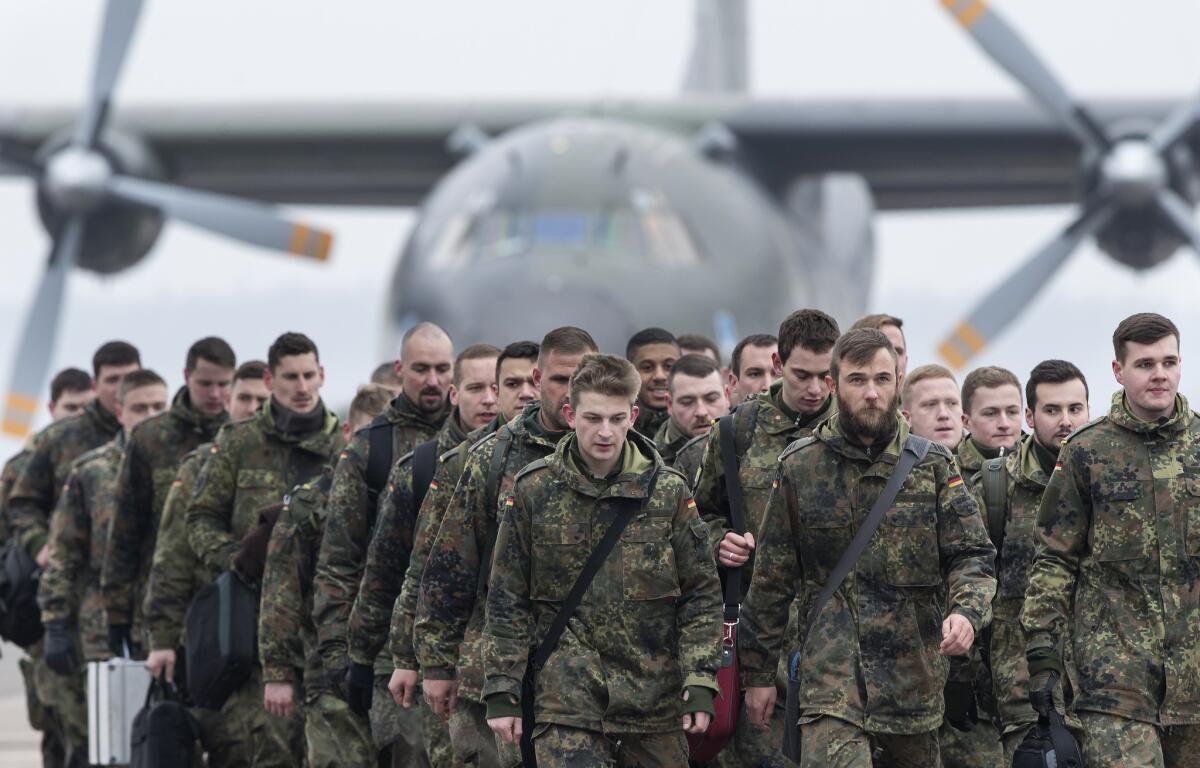President Trump wants other members of NATO to pay their fair share. Here’s what that would look like

- Share via
President Trump has talked a lot about getting other members of the North Atlantic Treaty Organization to pay their fair share when it comes to defending one another.
Article 5 of the North Atlantic Treaty — the 1949 pact that established the NATO alliance — says that an attack against one ally is considered an attack against all allies and that member states are committed to come to one another’s defense.
To ensure that allies are equipped to do that, NATO recommends that member states spend the equivalent of at least 2% of their gross domestic product annually on defense, including personnel, military equipment and research.
Besides the U.S., only four of the 28 NATO members meet that threshold: Estonia, Greece, Poland and the United Kingdom. None of them spend more than 2.38%.
At 3.61%, the U.S. spends more than any other country — an estimated $664 billion last year, or more than double the rest of all NATO countries combined. (NATO uses 2010 prices to track spending as a share of GDP over time. By that measure, the U.S. spent an estimated $608 billion on defense last year.)
Even if all NATO countries met the guideline, together they’d only be spending about two-thirds of what the U.S. spends.
By comparison, in 2015 non-NATO countries China and Russia spent 1.9% and 5.4% of GDP, respectively, or $215 billion and $66 billion, on defense, according to data from the Stockholm International Peace Research Institute.
On the campaign trail in 2016 and since his election, Trump argued that the U.S. shoulders an unfair share of the military burden when it comes to collective defense. He also called NATO “obsolete” because it was old and “wasn’t taking care of terror.”
“I said a long time ago that NATO had problems,” Trump said last month in an interview with the Times of London and the German publication Bild. “No. 1 — it was obsolete, because it was, you know, designed many, many years ago. No. 2 — the countries aren’t paying what they’re supposed to pay.”
Such remarks have worried European leaders, who have begun to take measures to make their nations more self-reliant in their defense.
“They’re worried about the mood in Washington,” said Nick Witney, a senior fellow at the European Council on Foreign Relations.
In November, the European Union proposed a plan, yet to be considered by member states, to start spending approximately half a billion dollars out of the E.U. budget on defense each year after 2020. The money would support research on defense technologies, such as encrypted software and robotics. A second component of the plan would raise $5.4 billion annually from member countries to develop and buy hardware.
At a December meeting in Brussels, the European Council — which includes the heads of state of each E.U. member country — concluded that “Europeans must take greater responsibility for their security” and comply with NATO spending guidelines.
Total military spending by Western Europe last year grew for the first time since 2009, according to Jane’s Defence Budgets Report, an industry publication.
Baltic States upped their defense budgets faster than any other region in the world. Latvia and Lithuania were poised to join Estonia in surpassing the 2% mark by 2018.
If every NATO country, including non-European Union countries, were to increase its defense spending to the recommended level, total defense spending by the alliance would go up from $890 billion to just over $1 trillion.
But experts say they don’t expect that to happen anytime soon, if ever.
“I don’t think there’s an appetite to go to 2%,” said Dan Jenkins, a defense and security researcher at Rand Corp. Europe. “There’s so much pressure on the whole of budgets across Europe.”
Many European Union countries face a competing mandate to reduce their budget deficits — a goal that would be difficult to reach while also significantly increasing military spending.
Take Italy, for example. It has the eighth-biggest economy in the world, but is still recovering from the 2008 recession and only spends 1.1% of its GDP on defense.
Spain, too, has suffered from a sluggish economy and a budget deficit well above the limit set by the European Commission. And although the German economy is stronger, going up from 1.2% to 2% of GDP would entail a $30-billion jump.
Still, NATO countries are expected to increase their spending gradually in the next five to 10 years, having signed a declaration at a 2014 summit in Wales that they would do so.
Once the spending levels do go up, a good chunk of the money will go toward personnel — a category that eats up more than half of each country’s military budget, on average.
NATO guidelines also recommend that member countries spend 20% of their defense budgets on major equipment — including items like Lockheed Martin’s F-35 fighter jet.
But how much of that money Lockheed or other U.S. companies are likely to get remains unclear.
“Two-thirds of European defense budgets are so small that they’re never going to be able to procure the high-end equipment that’s for sale in the U.S.,” said Jenkins.
And those that do have the resources, mostly in Western Europe, will probably buy local, said N.R. Jenzen-Jones, director of Armament Research Services, a consultancy.
Twitter: @AgrawalNina
ALSO
Ninth Circuit turns down Trump’s request to immediately reinstate his travel ban
Trump imposes sanctions on people and companies in Iran
Trump vowed to end ‘catch and release,’ but on the border, it’s business as usual
How Trump’s policies and rhetoric are forging alliances between U.S. Jews and Muslims
More to Read
Sign up for Essential California
The most important California stories and recommendations in your inbox every morning.
You may occasionally receive promotional content from the Los Angeles Times.











